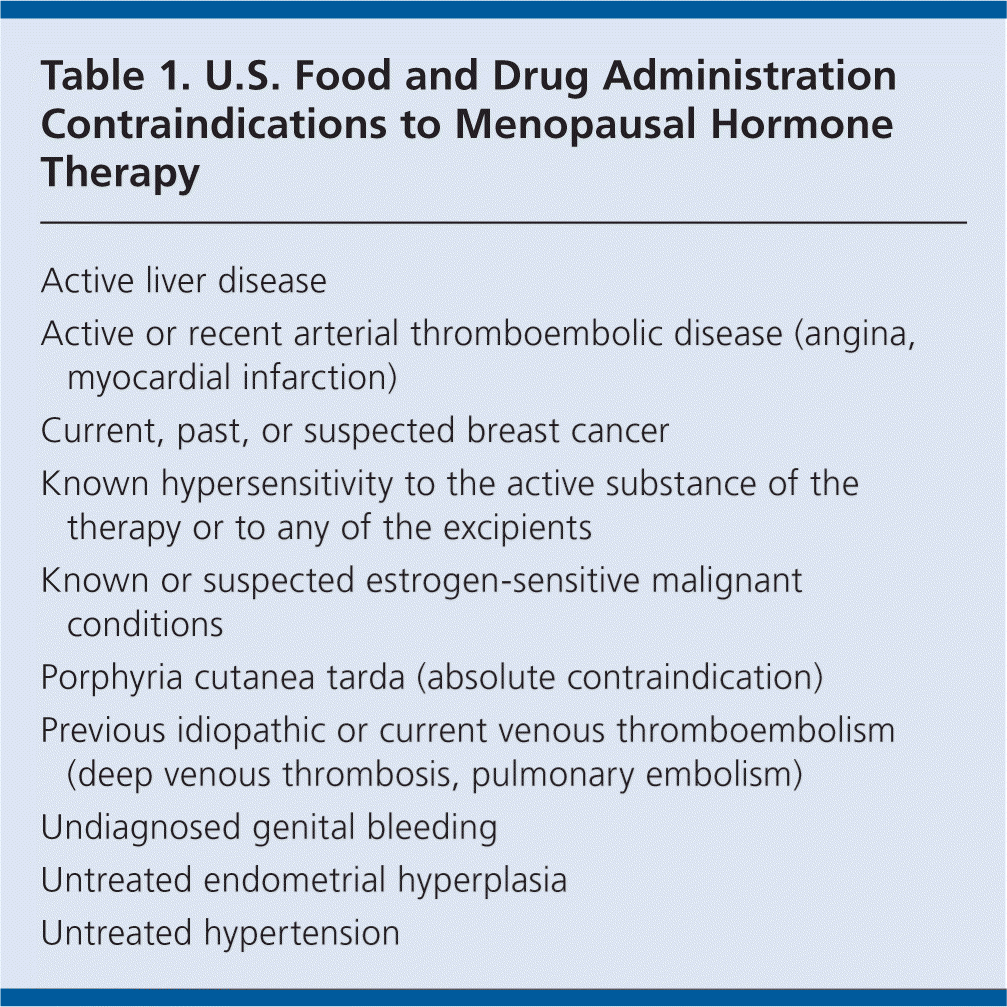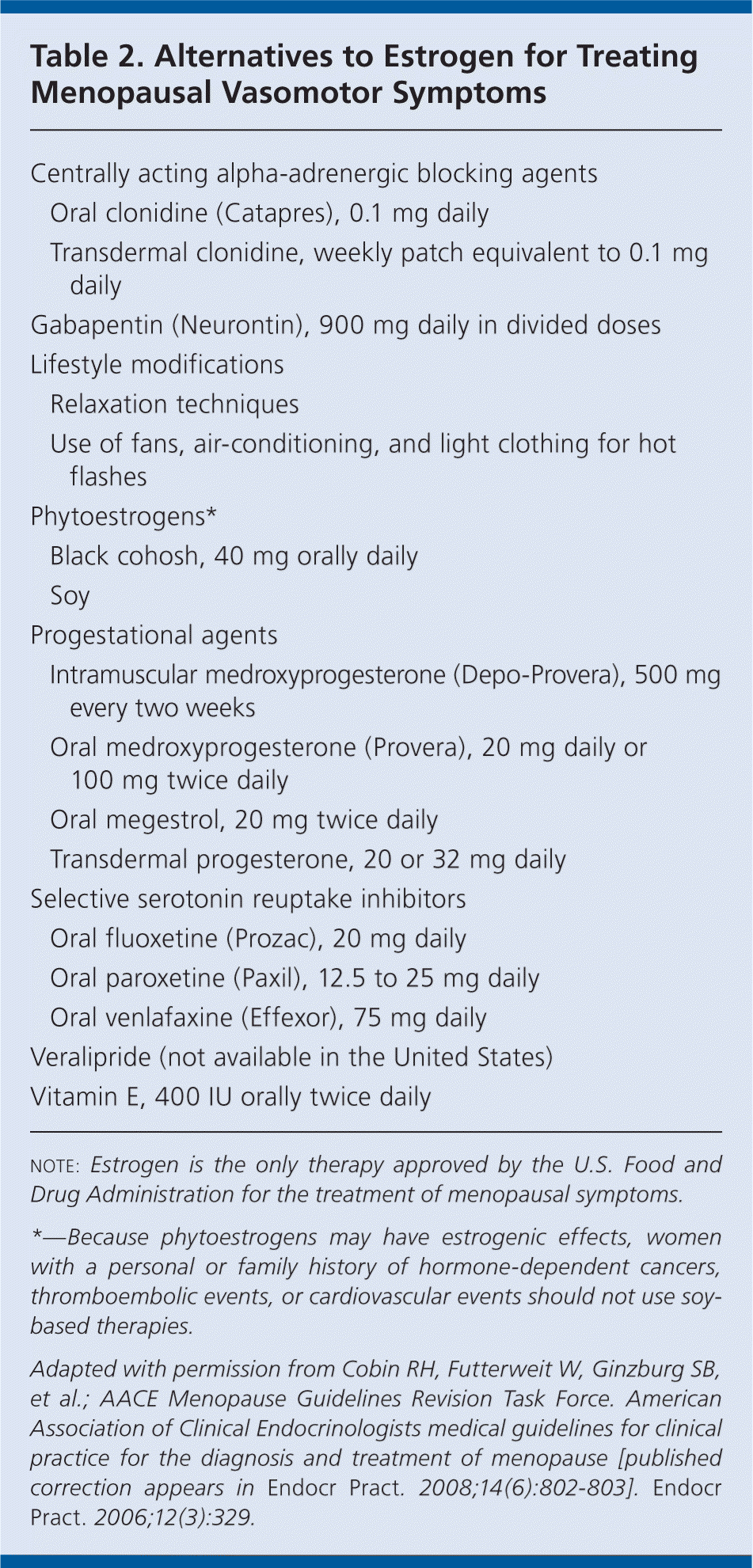
Am Fam Physician. 2012;86(9):864-868
Guideline source: American Association of Clinical Endocrinologists
Evidence rating system used? Yes
Literature search described? Yes
Guideline developed by participants without relevant financial ties to industry? No
Published source:Endocrine Practice, November/December 2011
Available at: https://www.aace.com/files/menopause.pdf
Menopause is diagnosed in women who have not had menses for one year. After menopause, up to 85 percent of women have symptoms such as hot flashes, sweating, insomnia, and vaginal dryness and discomfort. Although most symptoms resolve spontaneously after about five years, symptoms continue in a substantial number of women. Menopausal hormone therapy is the most effective treatment for these symptoms. The goal of this therapy is to improve quality of life, but possible risks must be weighed against the benefits of therapy. Chronic disorders are associated with aging and menopause. The role of menopausal hormone therapy in the prevention of these conditions is controversial.
The American Association of Clinical Endocrinologists (AACE) convened a task force to review available evidence on therapies for menopausal symptoms. The task force's guidelines include recommendations for prescribing menopausal hormone therapies, and for weighing the risks and benefits in individual patients.
Indications and Contraindications for Menopausal Hormone Therapy
Menopausal hormone therapy is prescribed in the perimenopausal period or during early menopause based on an individual patient's benefit-versus-risk profile. The U.S. Food and Drug Administration (FDA) has approved menopausal hormone therapy for moderate to severe vasomotor symptoms and moderate to severe vulvar and vaginal atrophy. Women who have had a hysterectomy should receive estrogen alone, and women with an intact uterus should receive estrogen plus a progestational agent to lower the risk of hyperplasia and endometrial cancer.
Table 1 lists FDA contraindications for menopausal hormone therapy. Therapeutic trials of prescription nonhormonal alternatives may be considered for the treatment of menopausal symptoms with no contraindications. However, over-the-counter supplements should be used with caution because they are not regulated by the FDA and may interact with other drugs. Table 2 lists alternatives to estrogen therapy for treating menopausal symptoms.

| Active liver disease |
| Active or recent arterial thromboembolic disease (angina, myocardial infarction) |
| Current, past, or suspected breast cancer |
| Known hypersensitivity to the active substance of the therapy or to any of the excipients |
| Known or suspected estrogen-sensitive malignant conditions |
| Porphyria cutanea tarda (absolute contraindication) |
| Previous idiopathic or current venous thromboembolism (deep venous thrombosis, pulmonary embolism) |
| Undiagnosed genital bleeding |
| Untreated endometrial hyperplasia |
| Untreated hypertension |

| Centrally acting alpha-adrenergic blocking agents | |
| Oral clonidine (Catapres), 0.1 mg daily | |
| Transdermal clonidine, weekly patch equivalent to 0.1 mg daily | |
| Gabapentin (Neurontin), 900 mg daily in divided doses | |
| Lifestyle modifications | |
| Relaxation techniques | |
| Use of fans, air-conditioning, and light clothing for hot flashes | |
| Phytoestrogens* | |
| Black cohosh, 40 mg orally daily | |
| Soy | |
| Progestational agents | |
| Intramuscular medroxyprogesterone (Depo-Provera), 500 mg every two weeks | |
| Oral medroxyprogesterone (Provera), 20 mg daily or 100 mg twice daily | |
| Oral megestrol, 20 mg twice daily | |
| Transdermal progesterone, 20 or 32 mg daily | |
| Selective serotonin reuptake inhibitors | |
| Oral fluoxetine (Prozac), 20 mg daily | |
| Oral paroxetine (Paxil), 12.5 to 25 mg daily | |
| Oral venlafaxine (Effexor), 75 mg daily | |
| Veralipride (not available in the United States) | |
| Vitamin E, 400 IU orally twice daily | |
Treatments
ESTROGENS
The lowest dosage of estrogen therapy that provides bone protection or relief from symptoms should be used. A reduction in dosage should be considered as the patient ages.
Common regimens include conjugated equine estrogen or synthesized conjugated estrogen (0.3 to 0.625 mg), micronized 17β-estradiol administered orally (0.5 to 1 mg) or intramuscularly, transdermal estradiol (25 to 100 mcg), ethinyl estradiol (0.01 to 0.02 mg), topical estradiol preparations, and vaginal estrogenic preparations (vaginal estradiol ring, conjugated equine estrogen cream, estradiol cream). There are few differences among the treatment methods, although the oral and transdermal routes are most commonly used.
The choice of estrogen should be based on patient preference and prior experience. However, the transdermal route is recommended for certain clinical situations, such as in women with hypertension, hypertriglyceridemia, and an increased risk of cholelithiasis, and possibly to reduce the risk of thromboembolic disease. Transvaginal estrogen may be considered to provide topical effects with less systemic absorption.
PROGESTATIONAL AGENTS
If a progestational agent is used in conjunction with estrogen, it should be taken a minimum of 10 to 14 days per month. Although amenorrhea may be achieved with daily use of a low-dose progestational agent, it is not recommended because recent studies have shown adverse breast outcomes with continuous therapy. Long-cycle use of progestational agents (14 days every three months) may be considered to reduce breast exposure, although the evidence is lacking.
Common choices of progestational agents include medroxyprogesterone (2.5 mg daily or 5 mg for 10 to 12 days per month), micronized progesterone (100 mg daily or 200 mg for 10 to 12 days per month), norethindrone (0.35 mg daily or 5 mg for 10 to 12 days per month), drospirenone (3 mg daily), and levonorgestrel (0.075 mg daily).
Combination medications with estradiol and a progestational agent are available. Switching among different types of progestational agents may decrease possible adverse effects.
BIOIDENTICAL HORMONE THERAPY
Compounded bioidentical hormone therapies are claimed to be identical in structure to human hormones. However, in many cases, this has not been biochemically substantiated, and the compounded therapies are not regulated by the FDA. Although some FDA-approved bioidentical hormone preparations may be considered for menopausal symptoms, there is little evidence that they are safer or more effective than traditional menopausal hormone therapy.
Analysis of Benefits vs. Risks
CANCER
Unopposed estrogen therapy has been associated with the development of endometrial cancer, and therefore a progestational agent should be added to prevent hyperplasia and endometrial cancer. Although data are conflicting, physicians should discuss with patients the possible relationship between menopausal hormone therapy and breast cancer. Evidence suggests that this potential relationship is stronger with estrogen/progestational agent combinations than with estrogen alone. Using micronized progesterone rather than medroxyprogesterone and avoiding combined continuous therapy may be associated with a lower risk. Although study results regarding the effect of menopausal hormone therapy on the risk of ovarian cancer have been inconsistent, women should be advised that there is a possible increase in ovarian epithelial tumors after more than 10 years of therapy. Studies have demonstrated a decrease in the incidence of colon cancer and related mortality in women taking menopausal hormone therapy.
VENOUS THROMBOEMBOLIC DISEASE
Estrogen therapy has been associated with an increased risk of venous thromboembolic disease within one to two years of initiation. Women at increased risk of disease should not take estrogen-containing therapy, although recent research suggests that transdermal estrogen may be safe. Aggressive smoking cessation is recommended for smokers who are considering menopausal hormone therapy because smoking increases the risk of venous thromboembolic disease in those who are taking estrogen.
STROKE
Some evidence shows that women on menopausal hormone therapy have more strokes, especially older women.
OSTEOPOROSIS
Menopausal hormone therapy should be used to prevent and treat osteoporosis when appropriate, after considering the risks versus benefits in the individual patient. Although nonhormonal therapies are available, randomized controlled trials have substantiated the benefits of estrogen in preserving bone mass and, less consistently, in preventing fractures.
DEMENTIA
Menopausal hormone therapy has not been shown to affect the risk of dementia and is not recommended to prevent or treat the condition.
CARDIOVASCULAR DISEASE
Menopausal hormone therapy should not be used in the primary or secondary prevention of cardiovascular disease. Lipid profiles, smoking history, and diabetes mellitus history should be considered before initiating therapy to determine individual cardiovascular risk. Smoking cessation is strongly advised for smokers who are considering menopausal hormone therapy because smoking increases the risk of cardiovascular disease in those who are taking estrogen.
